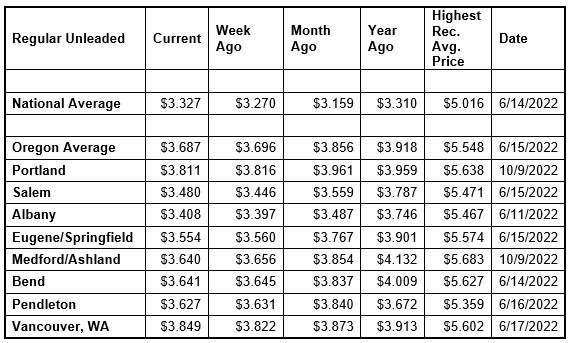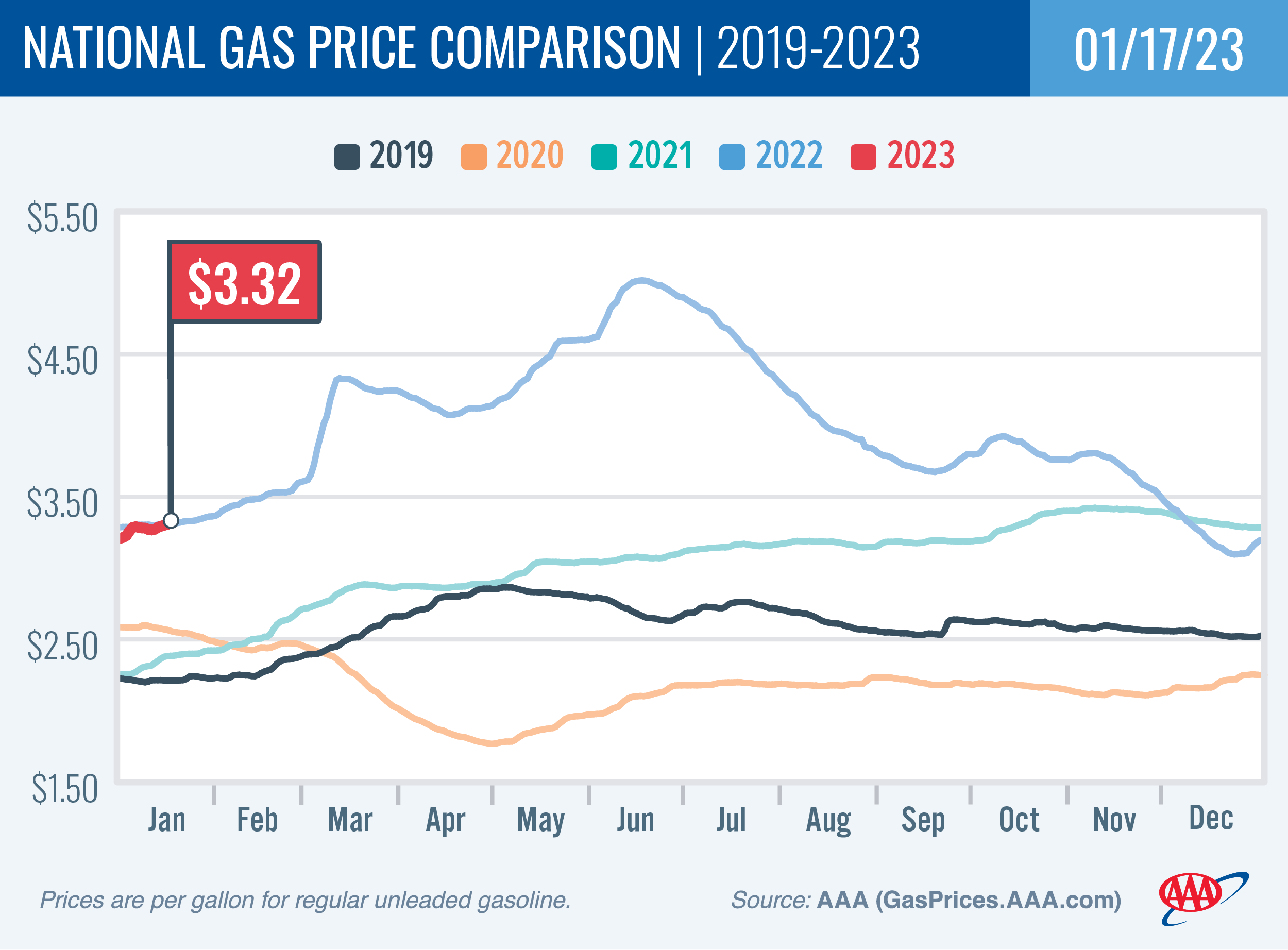Oregon has third-largest monthly and yearly drops in the nation
PORTLAND, Ore., – The short days and winter weather of January are making people drive less, lowering gasoline demand. But the price of crude oil has climbed higher as fears of a global recession ease. This is putting upward pressure on pump prices. For the week, the national average for regular unleaded rises six cents to $3.33. The Oregon average slips a penny to $3.69.

“Demand for gas is usually lackluster this time of year and typically starts to tick up as the days get longer and spring break gets closer. So the main driver of higher pump prices this time of year is the higher cost of crude oil, which accounts for more than half of what we pay at the pumps,” says Marie Dodds, public affairs director for AAA Oregon/Idaho.
Crude oil is trading around $80 per barrel. This month, West Texas Intermediate has ranged between about $73 and $81 per barrel and was $84 a year ago. Crude reached a recent high of $122.11 per barrel on June 8. The all-time high for WTI crude oil is $147.27 in July 2008.
Crude oil prices tend to rise in response to positive economic news as countries with growing economies tend to consume more oil than countries with shrinking economies.
Crude prices rose dramatically leading up to and in the first few months of Russia’s invasion of Ukraine. Russia is one of the world’s top oil producers and its involvement in a war causes market volatility, and sanctions imposed on Russia by the U.S. and other western nations resulted in tighter global oil supplies. Oil supplies were already tight around the world as demand for oil increased as pandemic restrictions eased.
Crude oil is the main ingredient in gasoline and diesel, so pump prices are impacted by crude prices on the global markets. On average, about 56% of what we pay for in a gallon of gasoline is for the price of crude oil, 20% is refining, 11% distribution and marketing, and 14% are taxes, according to the U.S. Energy Information Administration.
Demand for gasoline in the U.S. tumbled after Christmas and has remained pretty steady the past couple weeks, rising slightly from 7.51 million b/d to 7.56 b/d for the week ending January 6. This compares to 7.91 million b/d a year ago. Total domestic gasoline stocks rose from 222.7 million bbl to 226.8 million bbl. Flat gasoline demand and increased supply are contributing to limited pump price increases.
Quick stats
Oregon is one of only 11 states with lower prices week-over-week. Alaska (-2 cents) has the largest weekly drop, followed by Nevada (-2 cents) and Hawaii (-2 cents). Colorado (+33 cents) has the largest week-over-week increase, followed by Georgia (+30 cents) and Indiana (+17 cents). The averages in New York, Maryland and Delaware are flat.
Hawaii ($4.99) is the state with the most expensive gas in the nation for the eighth week in a row, and drops below $5 a gallon. California ($4.43) is second and Washington $4.00 is third. These are the only three states with averages at or above $4 a gallon. This week 40 states and the District of Columbia have averages in the $3-range, and seven states have averages below $3 a gallon.
The cheapest gas in the nation is in Mississippi ($2.93) and Texas ($2.95). For the 105th week in a row, no state has an average below $2 a gallon.
The difference between the most expensive and least expensive states is $2.06 which continues to be stark.
Oregon is one of 17 states with lower prices now than a month ago. The national average is 17 cents more and the Oregon average is 17 cents less than a month ago. Oregon has the third-largest monthly decrease in the nation. Idaho (-27 cents) and Utah (-21 cents) have the largest monthly declines. Colorado (+53 cents) and Wisconsin (+39 cents) have the largest monthly gains.
Oregon is one of 21 states with lower prices now than a year ago. The national average is two cents more and the Oregon average is 23 cents less than a year ago. This is the third-largest yearly drop in the nation. Montana (-34 cents) and Connecticut (-29 cents) have the largest year-over-year declines. Hawaii (+66 cents) has the biggest year-over-year jump.
West Coast
The West Coast region continues to have the most expensive pump prices in the nation with six of the seven states in the top 10. This is typical for the West Coast as this region tends to consistently have fairly tight supplies, consuming about as much gasoline as is produced. In addition, this region is located relatively far from parts of the country where oil drilling, production and refining occurs, so transportation costs are higher. And environmental programs in this region add to the cost of production, storage and distribution.
| Rank | Region | Price on 1/17/23 | ||
| 1 | Hawaii | $4.99 | ||
| 2 | California | $4.43 | ||
| 3 | Washington | $4.00 | ||
| 4 | Nevada | $3.94 | ||
| 5 | Alaska | $3.71 | ||
| 6 | Oregon | $3.69 | ||
| 7 | Pennsylvania | $3.65 | ||
| 8 | District of Columbia | $3.54 | ||
| 9 | Illinois | $3.53 | ||
| 10 | New York | $3.45 |
As mentioned above, Hawaii is the most expensive state in the nation, with California, Washington, Nevada, Alaska, and Oregon rounding out the top six. Arizona is 13th. Oregon is sixth most expensive for the second week in a row.
All states in the West Coast region are seeing relatively small changes for the week. Washington (+6 cents) has the largest weekly increase in the region. Alaska (-2 cents) has the largest weekly decline in the region and the country.
The refinery utilization rate on the West Coast slipped from 85.8% to 84.4% for the week ending January 6. This rate has ranged between about 76% to 92% in the last year.
According to EIA’s latest weekly report, total gas stocks in the region increased from 32.77 million bbl.to 34.07 million bbl.
Oil market dynamics
A lower dollar helped to push crude prices higher at the end of last week. Crude oil is priced in U.S. dollars so when the dollar loses value, crude oil becomes less expensive for investors using other currencies. Additionally, after China increased quotas for oil purchases this year, the market rallied as a sign that crude oil demand may be more robust than anticipated. For this week, crude prices could continue to rise if the market sees more indications that global oil demand may be boosted alongside prices in 2023.
At the close of Friday’s formal trading session, WTI increased by $1.47 to settle at $79.86. U.S. Markets were closed Monday in observance of the Martin Luther King Jr. holiday. Today crude is trading around $80, compared to $75 a week ago. Crude prices are about $2 less than a year ago.
Drivers can find current gas prices along their route with the free AAA Mobile app for iPhone, iPad and Android. The app can also be used to map a route, find discounts, book a hotel and access AAA roadside assistance. Learn more at AAA.com/mobile.

Diesel
For the week, the national average loses four cents to $4.60 a gallon. The record high is $5.816 set on June 19. The Oregon average falls four cents to $4.73. The record high is $6.47 set on July 3. A year ago the national average for diesel was $3.62 and the Oregon average was $4.05.
Find current fuel prices at GasPrices.AAA.com.
AAA news releases, high resolution images, broadcast-quality video, fact sheets and podcasts are available on the AAA NewsRoom at NewsRoom.AAA.com.
Find local news releases at https://oregon.aaa.com/community/media/media-contacts.html


